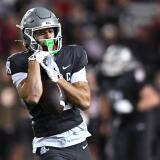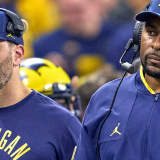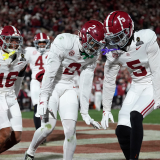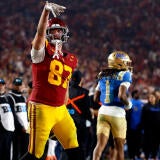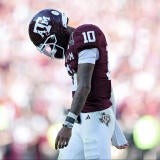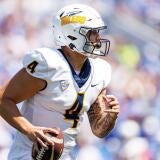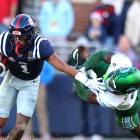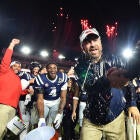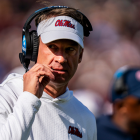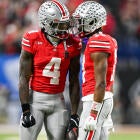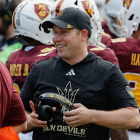College Football Playoff: Mismatches that will decide the Rose Bowl, Sugar Bowl
How the four playoff teams will exploit their opponents' weaknesses in the Monday's semifinal
The College Football Playoff semifinals kick off on Monday, Jan. 1, 2018. If you haven't already, you're going to hear a lot of narratives and big-picture storylines like "the Big 12 doesn't play defense" or "should Alabama have been the fourth team in?"
The results of the Rose and Sugar Bowls will shape these narratives. That's all well and good for conversation purposes, but the less trendy take is that what these games ultimately come down to are matchups. All four teams -- No. 1 Clemson, No. 2 Oklahoma, No. 3 Georgia and No. 4 Alabama -- are excellent. They wouldn't be here if they were not.
As such, each team has at least one strength that can exploit the weakness of its opponent. Below, we take a stats-based approach to break down the No. 1 mismatch each team can use to their advantage in the semis with plenty of help from Pro Football Focus, as well as additional numbers from Football Outsiders.
Sugar Bowl
Alabama: Run game versatility
Surprise, right? The Crimson Tide basically grow five-star running backs on trees. Plus, quarterback Jalen Hurts is a threat to score when he takes off to run, too. In all, Alabama has five options, including Hurts, in run-game productivity. The sheer number of ways Alabama can win in the ground game is what makes it a troublesome group for defenses.
Overall, not much has changed for the Tide's ground game in the grand sense. It's more about the little differences. Damien Harris is the best option and the big-play threat at 8.24 yards per carry, but one area in which Alabama is different under offensive coordinator Brian Daboll as opposed to Lane Kiffin is that Daboll is more deliberate in spreading the ball around instead of finding mismatches and repeatedly attacking them until they no longer work. Hurts leads the team with 137 carries (though that includes sacks) and Bo Scarbrough is still a force with more total touches now than ever before.
But now there are two more realistic options: freshman Najee Harris and sophomore Josh Jacobs. They've combined for 255 snaps, 582 rushing yards at six yards a carry and four touchdowns. Not bad for "backups" that would probably start at most Power Five programs.
| Player | Snaps | Rush Yds | Rec. Yds | Rush Avg. | Success rate (rank) | TDs |
|---|---|---|---|---|---|---|
Damien Harris | 283 | 906 | 66 | 8.24 | .420 (10) | 11 |
Jalen Hurts (QB) | 657 | 768 | -- | 5.61 | -- | 8 |
Bo Scarbrough | 264 | 549 | 92 | 5.08 | .376 (40) | 8 |
Josh Jacobs | 131 | 276 | 165 | 6.42 | -- | 3 |
Najee Harris | 124 | 306 | 23 | 5.56 | -- | 3 |
Minimum of 200 snaps
What makes Alabama-Clemson III interesting is that both of teams' biggest strength doesn't necessarily line up against its opponent's biggest weakness. However, they are the types of strengths that each opponent hasn't seen this season. For example, Clemson has one of the best defenses in college football in pretty much every category. But this will be an Alabama running attack that can hit you in the mouth with power, spread you out and make you defend in space and force you to play disciplined with the threat of Hurts keeping the ball. That's a lot of stress to put on a defense.
Clemson: Defensive line pass rush
Not too long ago, this was considered Alabama's mismatch. The Crimson Tide led the nation in sacks in 2016, have had four defensive linemen drafted in the past two years and could have another one or two drafted this spring. However, Clemson is making a strong statement as college football's new "D-Line U." The Tigers have also had four D-linemen drafted in the same two-year span and this group could be its best yet.
What stands out the most is how well Clemson gets to the quarterback using only its front four. The Tigers rank third nationally with 44 sacks -- that could change after the Sugar Bowl -- about two-thirds of which come from defensive linemen. S&P+ rates Clemson's D-line as the best unit in college football in adjusted sack rate.
Individually, Clemson's D-linemen grade lower than expected by PFF standards, but three of the starting four have been in at least 300 pass rush situations with pressure coming from a variety of sources. So, numerically, the sum is greater than the parts, even if the parts themselves are outstanding.
| Player | Stops | Sacks | Hurries | Pressures | Run def. grade (rank) | Pass rush grade (rank) |
|---|---|---|---|---|---|---|
| 18 | 4 | 12 | 18 | 81 (61) | 82.2 (24) | |
| 28 | 5 | 15 | 24 | 82.8 (35) | 78.7 (66) | |
| 36 | 7 | 22 | 42 | 85.3 (20) | 76.3 (72) | |
| 37 | 8 | 21 | 33 | 83.7 (34) | 67.2 (169) |
While Alabama has a good offensive line that run blocks well and protects Hurts, this will be the most dominant defensive front the Crimson Tide have faced this season. Alabama's lone loss came against Auburn, a game in which the Tigers got nine quarterback hurries on Hurts and two sacks. With Hurts' mobility in mind, Clemson's pressure could end up being the type that creates unclean pockets and gets Hurts out of his comfort zone.
Rose Bowl
Georgia: Power run game
Georgia keeps it simple, stupid, as well as any offense in the country. The Bulldogs run 77 percent of the time on first and second downs and are remarkably efficient doing so given the lopsided nature of their run/pass call percentage. That's bad news for Oklahoma, a defense not equipped to stop power running games.
Let's start with the "who." Nick Chubb, the team's leading rusher with 1,175 yards, is the veteran work horse with three 1,000-yard seasons on his resume. His blend of power, vision and single-cut ability makes him special runner. But while he's the 1A option, Sony Michel actually grades out better in many PFF categories and is the more dangerous runner. His ability to create on his own even with Georgia's excellent run blocking makes him a big-play threat every time he touches the ball. (And if you're asking, he's the more intriguing pro prospect.)
| Player | Success rate (rank) | Point of attack chg. (rank) | Explosive runs (rank) | 1st Downs/TDs (rank) |
|---|---|---|---|---|
Sony Michel | .410 (14) | .269 (14) | .134 (5) | .328 (20) |
Nick Chubb | .354 (69) | .229 (39) | 1.04 (22) | .292 (66) |
Minimum 200 snaps
While Chubb and Michel get the first nod, freshman D'Andre Swift (597 yards, 8.2 YPC, three TDs) is also an important part of the rotation. Swift doesn't see as many snaps as the other two backs, but he still grades out just as well as Michel in offensive success percentage (40.8), explosive runs percentage (14.5) and first down/touchdown gained percentage (38.2).
Now for the "why." Georgia's offensive plan is rarely flashy, but it's effective. The Bulldogs' success rate ranks fourth in the country, according to S&P+ metrics, with a simple explanation that success on standard downs leads to even more success in passing situations. Here's how the Bulldogs rank in major S&P+ offensive categories:
| Success Rate+ (rank) | Rushing S&P+ (rank) | Passing S&P+ (rank) | Standard Downs (rank) | Passing downs (rank) |
|---|---|---|---|---|
125.8 (4) | 128.1 (8) | 133.3 (4) | 122.6 (7) | 144.0 (3) |
It's about quality, not quantity. Georgia runs just 64 plays per game, 45 of which are on the ground. The blocking and diversity of makes the run game so difficult to stop and it opens up opportunities for quarterback Jake Fromm down the field.
Meanwhile, the Sooners struggle to stop the run. By the same metrics, Oklahoma ranks 62 in run defense and 70 in standard down situations. Chalk those up to Big 12 offenses if you must, but OU's worst game of the season in run D came against Kansas State (268 yards, 6.38 yards per rush, four TDs), a team that slows things down -- the Wildcats ran 56 plays that day -- and utilizes power run concepts. If Georgia gets its ground game going in the Rose Bowl, which is to be expected, it'll be a long day for the Sooners.
Oklahoma: Receivers/tight ends
Last season, Oklahoma had three primary offensive weapons: receiver Dede Westbrook and runnings backs Joe Mixon and Samaje Perine. Together, they accounted for 62 percent of the touches and offensive touchdowns, along with 64 percent of the yards from scrimmage. This season, the Sooners lack that single standout skill player, especially in the receiving game, but in a way that actually makes them harder to defend. They're far more diverse offensively and more efficient than a year ago. Defending every option is a seemingly impossible task for Georgia's defense, as stingy as it may be.
Despite popular narratives, Oklahoma's Air Raid isn't of the dink and dunk variety. Heisman Trophy winner Baker Mayfield has more deep throws (79) than screens (56) and ranks in the top 15 nationally in the former category. His 11.8 yards per attempt leads the FBS. However, Georgia has an excellent secondary. Corners Deandre Baker and Aaron Davis grade out as "elite" and "very good", respectively, in pass coverage by PFF with Baker performing at ridiculously high levels.
Deandre Baker was a force in coverage - leading all SEC CBs this year with his 372 snaps in coverage without a TD allowed. pic.twitter.com/rtzmO8JbuT
— PFF College Football (@PFF_College) December 15, 2017
That means Oklahoma may have to rely on short-to-intermediate throws to get its speedy receivers open. This is where coach Lincoln Riley excels as a play caller (and where OU's receivers excel as route runners). A prime example is the 55-yard touchdown from Mayfield to Mykel Jones in the Big 12 championship game. By clearing out the underneath part of the field, Jones had a preferred matchup against TCU defensive end Mat Boesen.
Putting pressure on Georgia's linebackers to defend in space when Oklahoma has five legitimate wide receiver/tight end options is a lot to handle. Roquan Smith is one of the best linebackers in the country in pass coverage, but he's just one player. This is what the Bulldogs' defense has to defend, per PFF.
| Player | Rec. | Yds. | TDs | Pos. Rating (rank) | Success Rate (rank) |
|---|---|---|---|---|---|
27 | 400 | 3 | 150 (2) | .594 (7) | |
39 | 724 | 7 | 140.8 (4) | .593 (8) | |
Mykel Jones | 16 | 310 | 1 | 135.4 (12) | .650 (3) |
Marquise Browns | 50 | 987 | 6 | 131.9 (20) | .486 (75) |
Minimum 200 snaps
That's not including tight end Mark Andrews, the Mackey Award winner, and utility weapon Dimitri Flowers. Both are matchup nightmares because of their size-speed combination. Dropping seven or eight players into coverage -- a common practice against Big 12 offenses this season -- will be a fascinating matchup if Georgia uses it because creating space for wideouts is what the Sooners do best.


